This tranquil scene of the Broomielaw quayside viewed across the river from the Bridge Hotel was captured by Thomas Annan in 1865 and, judging from the absence of people, it was probably taken early on a Sunday morning. Glasgow Bridge is on the right and the steamers Vesta (left) and Eagle are moored beside the deserted Broomielaw wharf. Behind is the Lord Byron Hotel and, in the latter half of the next decade, the buildings to the left of it would be cleared to make way for the Caledonian Railway Bridge and Glasgow Central Station. ( Courtesy of the Graham Lappin Collection )
Glasgow Bridge, also known as Jamaica (Street) Bridge and previously as the Broomielaw Bridge, was designed by the Scottish civil engineer Thomas Telford and opened on 1st January, 1836. This albumen photograph, taken by James Valentine, probably dates from the early 1870’s and, on close examination, tramlines are visible in the road surface. These form part of the route opened on August 19, 1872 between St. George’s Cross and Eglinton Toll, operated by the Glasgow Tramway and Omnibus Company. Notably absent from the scene are Central Station, the Caledonian Railway Bridge and the St. Enoch Hotel which were not completed until 1879. The spire in the photo is that of St. Enoch Church in St. Enoch Square. The Lord Byron Hotel is now renamed the Lord Byron Temperance Hotel and it makes for an interesting contrast with the Custom House Wine Vaults across the way on Great Clyde Street. The Custom House itself is next door and in front of it on Custom House Wharf a steam crane is operating. It was to this wharf that sand, gravel and granite would be brought into the city centre from distant quarries by small coastal vessels. In the second half of the 19th Century, photography was becoming increasingly popular and in this scene there are two rooftop photographic studios, Bowman’s and Urie’s.
In this photograph, taken around 1900/1901, the bridge has been rebuilt and the road widened. Gone are the gas lights on the parapets and they have been replaced by electric lights running along the centre of the roadway. Horse-drawn trams now operated by Glasgow Corporation Tramways are crossing the bridge and the one in the foreground is headed for Paisley Road Toll. On the other side of the river, passengers are waiting at the Glasgow Bridge (Jamaica Street) landing stage for the river ferries known as Cluthas, named after the Gaelic word for Clyde. The service was introduced on 12th April, 1884 and by the time this photo was taken, twelve of these small steam vessels were calling at nine intermediate landing stages between Victoria Bridge and Whiteinch. The Caledonian Railway Bridge is now in place on the far left, leading into Central Station, and the large St. Enoch Hotel is just visible on the right of the photograph.
A Clutha ferry is approaching the Glasgow Bridge landing stage from the west in this 1901/1902 scene and, in the distance, visible through the first arch of the road bridge, a coaster is moored at the Custom House Quay. Perhaps it has brought in a cargo of granite setts to surface the city’s streets. A train has just left Central Station and the locomotive is hauling a rake of Caledonian railway carriages liveried in plum with white upper panelling across the steel bridge. Two open top tramcars are visible on Glasgow Bridge and the system has recently been electrified. ( Courtesy of the Graham Lappin Collection )
Between 1901 and 1905, major reconstruction was taking place at Glasgow Central Station. The number of platforms increased from eight to thirteen and the station was extended over the top of Argyle Street. An additional eight-track bridge was built over the river, immediately west of the original railway bridge. In this photograph, the scaffolding for the new bridge construction can be seen through the gap underneath the existing railway bridge. There is a subtle difference between the two different electric tramcars on the road bridge. The tram nearest the camera with five windows each side is a purpose-built electric car while the other tram which has six windows each side is a converted horse car. There were simply not enough new purpose-built electric trams produced to meet the needs of the newly electrified system, so up to 120 horse tram bodies were converted for electrical use. ( Boots Cash Chemists, “Real Photographic Series” )
Across the river, the Clutha pier at Glasgow Bridge is now closed and abandoned. The river ferry service ended on 30th November, 1903, having fallen victim to competition from the electric tramcars. Judging from the open top tramcars and the abandoned Clutha stage, this photograph was probably taken sometime between 1904 and 1909. The large St. Enoch Hotel is now clearly visible on the right of the photograph and the domed building is located on the corner of Buchanan Street and Argyle Street. ( Postcard by E. A. Schwerdtfeger & Co., London E.C. )
This photograph, taken between 1910 and 1914, shows busy pedestrian, horse-drawn and tramcar traffic crossing Glasgow Bridge, probably on a Saturday. The horses in the foreground are taking a well-earned rest and feeding from nosebags before they haul their next loads of what appears to be sand. The canopy of St. Enoch Station, the Glasgow & Southwestern Railway terminus, can be seen to the right of the St. Enoch Hotel. A group of men in the foreground are sharing a joke at someone’s expense. There are advertisements in the photograph advocating the use of B.D.V. tobacco, Melrose Teas and Oxo flavouring. Oxo at that time was sold in bottles as a liquid extract. ( Postcard by E. A. Schwerdtfeger & Co. London E.C. )
A coastal steamer is just about to pass underneath Glasgow Bridge. The vessel is light in the water, having delivered its cargo at Custom House Quay before canting and returning downstream to pass under the bridge at low water. The mast has been lowered and the hinged funnel tilted back so that it can clear the central arch. It would take skill to steer it through. ( Postcard published by Judges Ltd. of Hastings. Courtesy of the Graham Lappin Collection )
In this early 1920’s scene, photographed from Carlton Place, the internal combustion engine is becoming more evident on Glasgow’s streets, in this case in the form of a motorised lorry. The angle of the photograph gives a pedestrian’s eye view of the scene and the complex criss-cross girders of the Caledonian Railway Bridge are clearly visible as are the elegant and ornate street lamps on Glasgow Bridge.
Here, three charabancs are seen in the early 1920’s, parked on Carlton Place just round the corner from Jamaica Bridge. The term charabanc is derived from the French “char a bancs” meaning a carriage with wooden benches and the original charabancs were horse-drawn. Later, motorized versions were introduced and they were open-top vehicles used for touring. In the event of rain, which is frequent in the West of Scotland, the folded canvas top stowed at the back could be brought to use, though this would often require some heavy lifting, especially if the canvas was wet. Because of this and the increased risk to passengers if the vehicle overturned, motorized charabancs were relatively short-lived and were replaced with conventional enclosed buses as seen in the next photograph.
This photograph of the eastern side of the bridge clearly shows the elegance of Telford’s original seven arches and the granite balustrade which were retained by public insistence when the bridge was widened in the late 1890’s. Buses are now in evidence on Glasgow’s streets when this photograph was taken, probably in 1923/24. There are two 14-seater Beardmore vehicles heading south on the bridge and parked in the foreground on Carlton Place is a Lancia on the left and a Reo on the right. The Lancia is in the service of William J. Wright and working the Glasgow – Kilmarnock service via Barrhead, Neilston, Caldwell Estate, Dunlop and Stewarton while the Reo, labelled a Comfort Coach, operated Whatmough’s Pullman service to Gourock, via Renfrew, Bishopton, Langbank, Port Glasgow and Greenock. The building on the skyline is the Central Hotel, adjacent to Central Station.
Legends © Christopher J. Jones
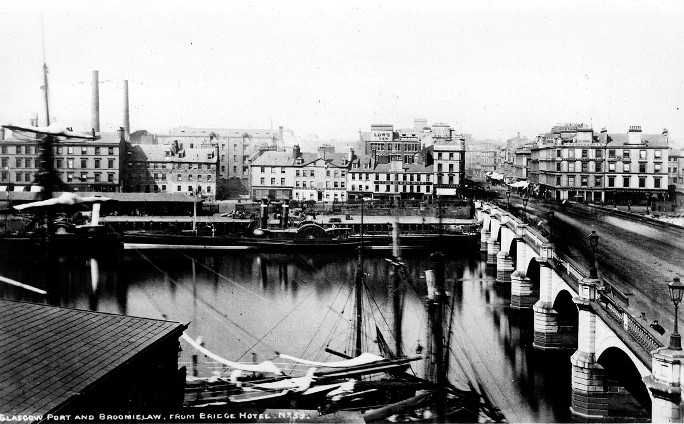
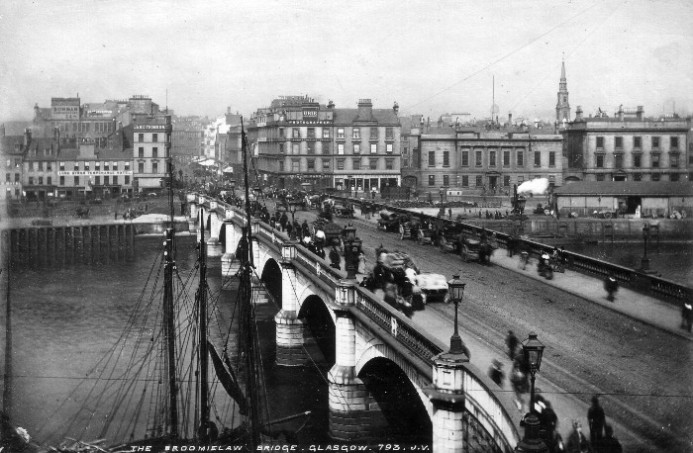
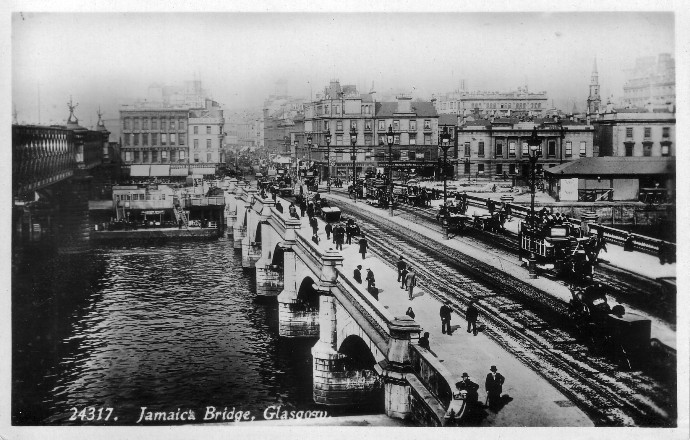
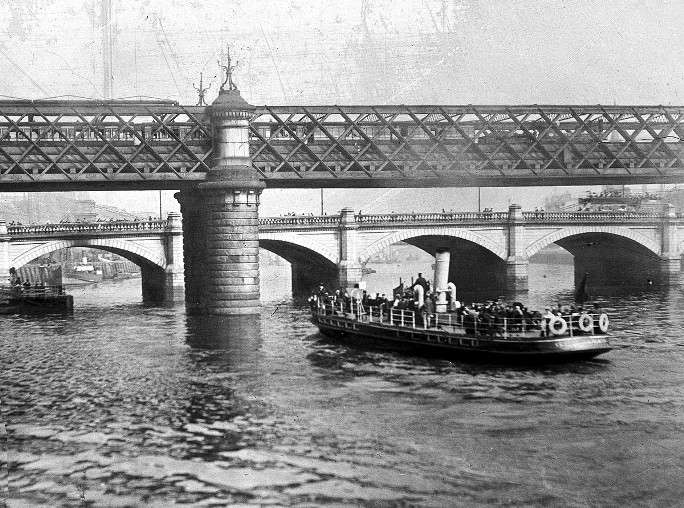
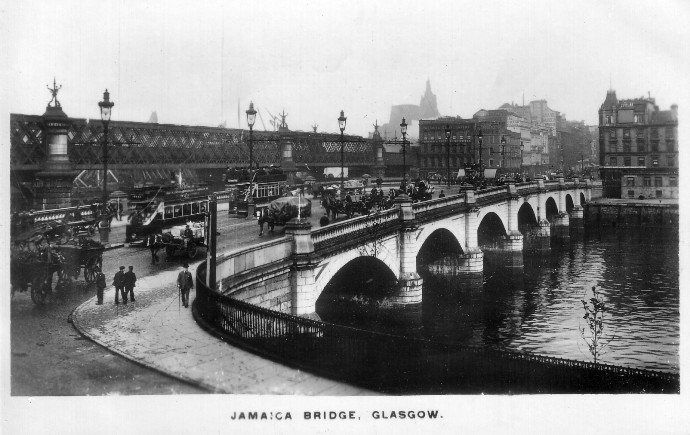
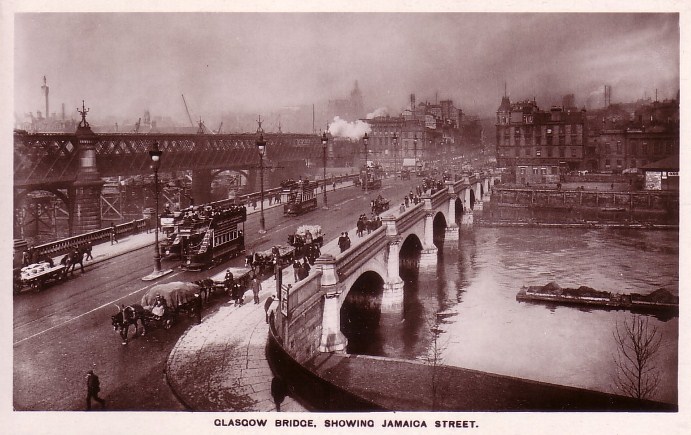
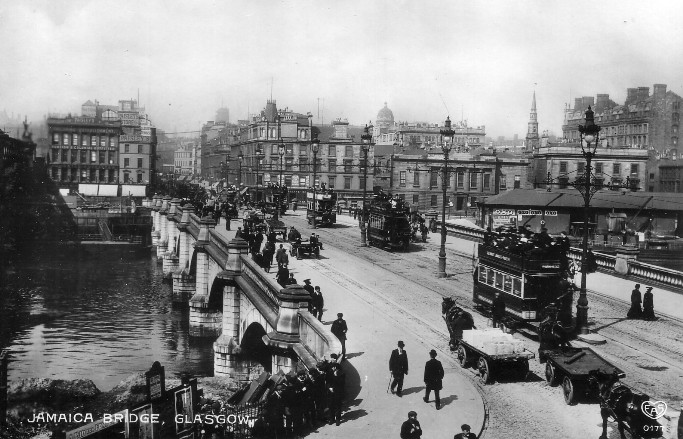
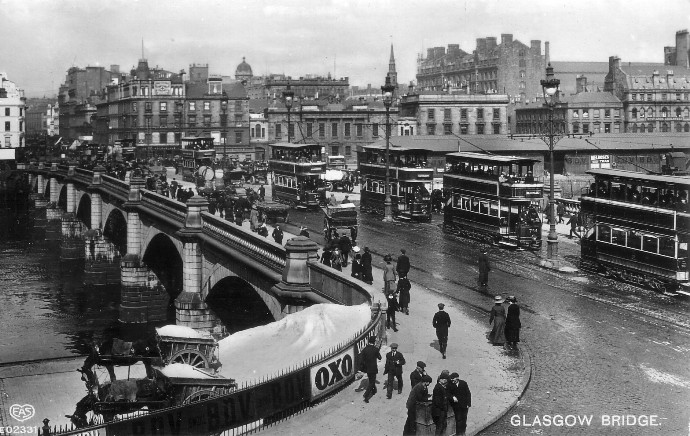
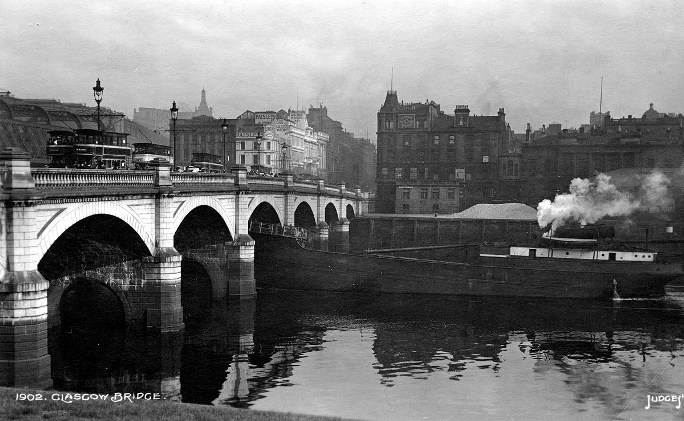
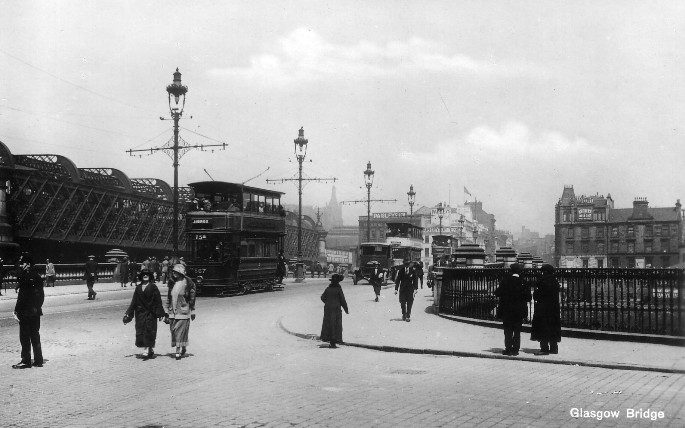
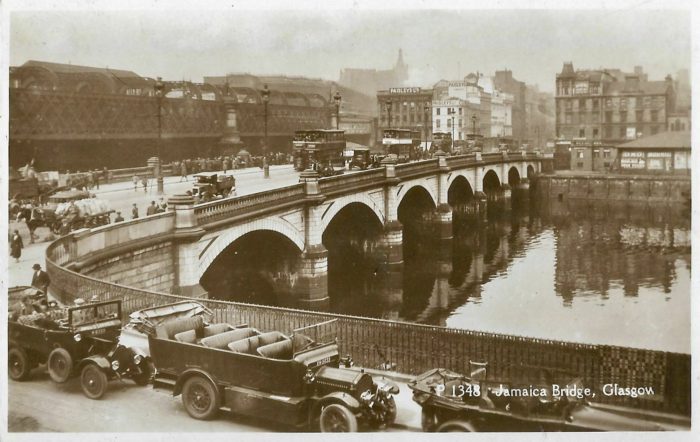
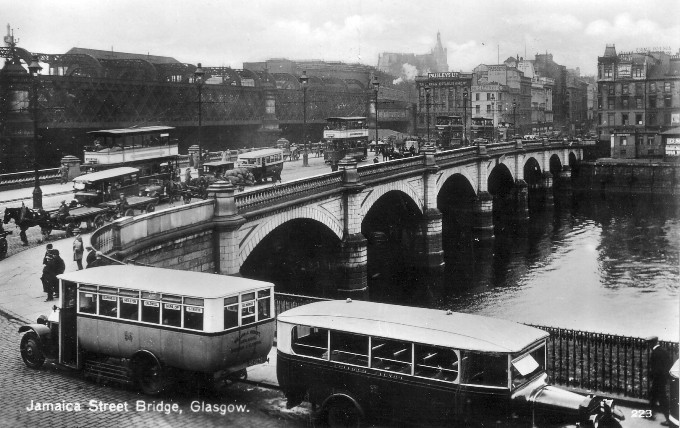
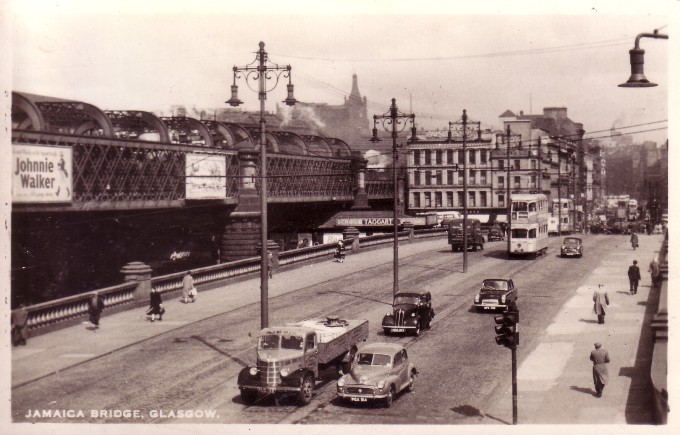
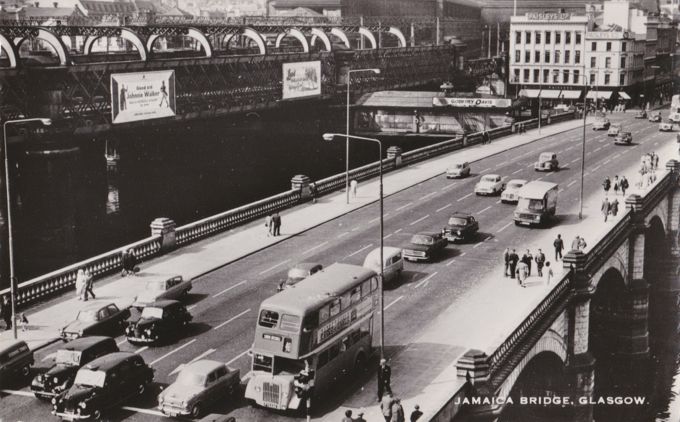

{ 19 comments… read them below or add one }
Great pictures, I had forgotten what it looked like when I was young.
Many thanks.
I came across this postcard on Flickr which I thought would make a nice contribution to your collection of Bridge Street views.
http://farm4.static.flickr.com/3657/3449523819_8c5a41a952_o.jpg
Thanks Kris for bringing this to my attention. Do you know if permission is required to reproduce photos from Flickr?
I seem to remember being able to walk from one side of the road to the other through a passage way under the Jamaica Bridge or am I wrong?
Wonderful pictures of the Glasgow Bridge,
Just to say thank you for making them available to view.
You’re very welcome.
These are fantastic, wonderful to see the old steamers and the clothes people were wearing too. Thank you.
You’re most welcome. Thank you for visiting this website.
We used to run over these bridges in the 60s and time ourselves:)as we used to go to Buchan St. Primary (now the courts). We didn’t have much, but it was a happy childhood.
Dear Glasgow History,
Thank you for these historic and progressive photos of Jamaica Bridge. I was born in Oakbank Hospital in the Cowcaddens in 1946. I lived opposite Buchanan Street Station /The Annan Fountain and the Gushet Pub. until 1954, when I moved out to Westerton in Bearsden. We managed Pirie’s Farm in Westerton before Drumchapel was even built. I left school at 15 and went to the shop called Paisley’s over Jamaica Bridge to collect my first set of Decorator’s overalls as I started my Apprenticeship in 1961 with John Orr & Sons. Decorators of 15, Blythswood Square, Glasgow. Working in My Magic City of Glasgow.
Dear Winston,
Thank you for your message and for sharing your personal story. There is a photograph of Oakbank ( Western District ) Hospital in Peter Stewart’s excellent book “Images of Scotland: Central Glasgow”. The hospital was built in 1904 and closed in 1971. You lived just up the street from the mother of a correspondent in the Sauchiehall Street section of this website. She lived at an address in West Nile Street until 1954 when she was 12. It must have been quite a change when you moved out from the city to open countryside with your family to manage the farm. As for Paisley’s, they were a fixture at the corner of Jamaica Street and the Broomielaw from around 1880 until 1979 and were renowned known for supplying uniforms for school and professional use.
Hi Chris,
Thanks for this wonderful collection – quite a discovery! I came across it while recalling the inscriptions on the redundant piers of the original Caledonian Railway Clyde viaduct leading into Glasgow Central station, which led in turn to the website http://www.walkingheads.net/art-stands-firm-clyde/ which includes the following – I did not realise the work was as recent as 1990!
“On the sturdy granite pillars that once held up another rail bridge are carved, in Greek and in English, the phrase, derived from Plato’s Republic ‘All greatness stands firm in the storm’.
This is the work of the internationally renowned Scottish artist Ian Hamilton Finlay. Carved in 1990, Glasgow’s year as European Capital of Culture, the pillars do indeed stand firm, but like so much of Glasgow’s industrial heritage which was built to last, their original purpose has become redundant.
Is Finlay’s work a celebration of the pillars’ survival or an ironic statement about imperial decline? Either way, the work challenges the viewer to reflect on an ever-changing city.”
Bob
Hi Bob,
Thank you very much for your comment and contribution to Glasgow History. No one can take away Glasgow’s past greatness, wrought by its unique people and rich resources. Now, we have the honour to talk and write about it.
Best wishes,
Chris
On the British Film Library website is a 1901 movie showing Jamaica Street:
https://player.bfi.org.uk/free/film/watch-jamaica-street-glasgow-1901-1901-online
At the 1min 30sec point, on the left of the movie image, you can see one of substantial bridge balustrades/posts – I think this is the corner with Broomielaw (see Google StreetView: https://goo.gl/maps/Jgy8pbQhqr92).
Bill
Hello Bill,
Thank you for your comment. I am overseas and far from Glasgow at the present time but I believe your identification is correct. The film is posted on this website. I would still like to find out the nature and location of the parade that featured later in the film.
Best wishes,
Chris
Hi Chris,
My great grandfather joined the army from 22 Bridge Street, Glasgow during WW1. Can anyone confirm if there were other Bridge Streets in Glasgow at the time or if the building that still stands is the very same 22 Bridge Street?
Many thanks.
Mary
Hi Chris,
Great article!! I’m researching Thomas Kay, a master carver and gilder, commissioned to produce a piece for Broomielaw Bridge in Glasgow to commemorate Queen Victoria’s visit by steam yacht in 1849. Are there any images of this piece? Thanks!
John
Hi John,
Thank you for your comment and inquiry. I’m assuming that the piece to which you refer was carved in stone rather than in wood as it was to be incorporated in the bridge. Photography was in its very early stages in 1849 so it is unlikely that the piece was photographed. However, Thomas Kay presumably drew out the design before he began carving, and drawings and possibly prints may have been made by others, once the existence of the panel became public knowledge. The installation of the panel would probably have been reported in the local press, so for newspapers, you may wish to contact the Mitchell Library in Glasgow. There may also be archival records and you might begin by contacting the University of Glasgow Archivist and also the Hunterian Museum which is at the University of Glasgow. If they cannot help directly, they may offer suggestions.
Wishing you success.
Chris
Hi Chris,
I was reading Jules Verne’s book, “The Green Ray”. At the beginning of Chapter 4 there’s a painting of the Bridge!!! It’s in the German version of the book from 1887. Amazing how almost similar are the 2nd and 3rd photographs in your beautiful and very interesting historical article herein.
Thanks, Elan